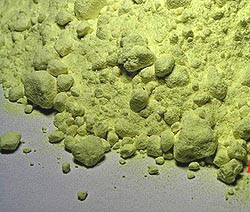Sulfur
From PyroGuide
Formula: S
Description: Sulfur has always been used extensively in pyrotechnics. It serves as a fuel, and reduces the ignition temperature of mixtures. It also tends to increase the burning rate and friction or shock sensitivity of most mixtures.
Hazards: Sulfur can increase the sensitivity of some mixtures, especially those based on chlorate or perchlorate oxidizers. Mixtures of chlorates and sulfur are also known to ignite spontaneously and should therefore be avoided at all times (also read the safety section). Mixtures of perchlorates and sulfur are less likely to ignite spontaneously but are still very sensitive and need to be treated with extreme caution. Burning sulfur produces sulfur dioxide gas, inhalation of which should be avoided because it is extremely poisonous. Because sulfur is a very important chemical it is listed in the Beginners’ pages.
Sources: Sulfur is available from agricultural supply stores where it is sold as a fungicide under the name 'dusting sulfur'. It is a fine powder mixed with a few percent of calcium carbonate. The calcium carbonate may disturb delicate color compositions, but for most purposes dusting sulfur works well. If a purer form of sulfur is required, sulfur may also be obtained from drug stores sometimes. However, these often sell 'flowers of sulfur', which has been purified by sublimation and which contains some acid. This needs to be neutralized before use as it could cause spontaneous ignition. To do this, allow 100g of this sulfur to soak in a liter of water/household ammonia (1:5). Stir well occasionally and measure the pH. It should still be alkaline after two days, after which time the sulfur may be filtered and washed with hot water to remove the ammonia. Check the pH of the washing water while filtering. After it has become neutral, flush the water away with ethanol and allow the sulfur to dry. Mix the dry powder with 2% magnesium carbonate to neutralize any acid that may be formed in reactions with the atmosphere.
Where to buy: You can buy High Quality Sulphur (S) from http://www.HobbyChemicals.co.uk
| Sulfur name and characteristics | |
| Amorphous Sulfur | Rapidly cooled sulfur not soluble in CS2 |
| Bright Sulfur | Crude sulfur without discoloring impurities |
| Brimstone | Crude sulfur |
| Broken Rock Sulfur | Refined sulfur mixture of lumps and dust |
| Colloidal Sulfur | Sulfur that has been chemically precipitated in water |
| Crude Sulfur | Bright or dark sulfur, free of Se, Te and As |
| Dark Sulfur | Crude sulfur with hydrocarbon contamination |
| Dusting Sulfur | Crude or refined powdered sulfur |
| Elemental Sulfur | Native sulfur at least 99.5% pure |
| Flour Sulfur | Crude sulfur 200 – 300 mesh |
| Flowable Sulfur | Colloidal or agricultural sulfur |
| Flowers of Sulfur | Sulfur purified by distillation (actually sublimation) |
| Frasch Sulfur | Native sulfur from superheated water injection |
| Insoluble Sulfur | Flowers of sulfur treated with carbon disulfide |
| Lac Sulfur | Precipitated from polysulfide solutions, up to 45% CaSO4 |
| Native Sulfur | Naturally occurring elemental form – often large crystals |
| Precipitated Sulfur | Precipitated from polysulfide, washed with HCl |
| Prilled Sulfur | Crude sulfur in small round pellets |
| Recovered Sulfur | Elemental sulfur from any combined sources |
| Refined Sulfur | Distilled sulfur more than 99.8% pure |
| Rubber maker’s Sulfur | Ground sulfur with low acid, ash and moisture content |
| Run-of-Mine Sulfur | Frasch sulfur with lumps and fines |
| Slated Sulfur | Crude sulfur that solidified on a moving belt |
| Virgin Rock and Roll Sulfur | Refined sulfur at least 99.8% pure, cast or in lumps |
| Wettable Sulfur | Powdered and treated for easy water dispersion |

